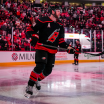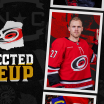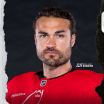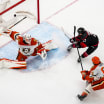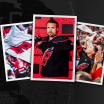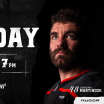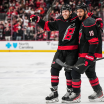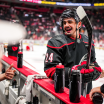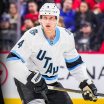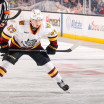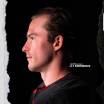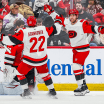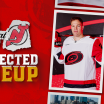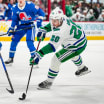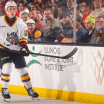Hello and welcome to Tweetmail, a weekly feature on Hurricanes.com in which I take your Twitter questions about the Carolina Hurricanes or other assorted topics and answer them in mailbag form. Hopefully the final product is insightful to some degree, and maybe we have some fun along the way.
Let's get to it.
Tweetmail No. 227: Equipment, Salary Cap & Changeover
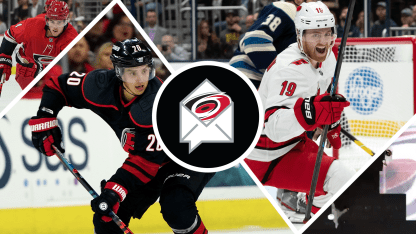
By
Michael Smith @MSmithCanes / CarolinaHurricanes.com
How often do players go through equipment? @MSmithCanes
— Melanie Dunia (@Melaniedunia) November 5, 2019
The short, basic answer: It varies, depending on the player and depending on the piece of equipment.
The longer, better answer: I asked some folks!
I had a hunch that sticks would be the piece of equipment players go through the quickest. That hunch was accurate.
Sebastian Aho said he uses 82 sticks in a season, one for every game. Head coach Rod Brind'Amour, who said he otherwise didn't switch equipment often, would work through a rotation of sticks.
"I never even had a pattern because I was changing all the time," he said. "I would just grab a generic one and play with it and try to make it right."
There isn't much consensus beyond the stick. Aho, for instance, said he will usually use around six pairs of gloves in a season, but he's got just as many stuffed in his locker stall right now.
"It's a little more because there have been adjustments," he said.
Dougie Hamilton, meanwhile, is more conservative with gloves.
"I don't like new gloves," he said. "I try to break in a couple in the summer and use those for the season."
And skates? Aho will use three to four pairs in a season. And for Hamilton, "it really depends," he said.
I caught a glimpse of Hamilton's shin pads on the floor. They were certainly not new.
"My shin pads I've had since my first year in junior, so 2009," he said with a smile. "I just like them. I have another pair of these, but they don't feel the same."
When it comes to equipment, feel is everything, and every player has a different feel for different pieces of equipment.
"Everyone is different with everything," Hamilton said.
"I didn't mess with my stuff at all," Brind'Amour said. "Shoulder pads I wore for 20 years. Elbow pads, shin pants, pants, everything. The helmet I had was old until the end. I didn't like new equipment at all. Sticks, everybody likes new."
Will the Hurricanes be buyers at the deadline if they continue winning or will they stick with the same group like last year?
— Chris (@trevor_simora) November 5, 2019
It's pretty early to be talking trade deadline, but I think it's safe to preemptively head this off at the pass. (
)
I don't expect the Hurricanes to be buyers at the deadline, and I don't expect that to change between now and Monday, Feb. 24.
Why? A couple of reasons.
The most notable reason is the lack of cap space. The Canes just don't really have room to make an addition without pairing it with a subtraction of similar monetary value right now. Another reason
Another reason is that prices at the deadline are just too steep. Teams aren't making hockey trades but often rather mortgaging their future to acquire temporary improvement. Just look at what Columbus did last season.
What the Canes would be interested in is a hockey trade, like the move to acquire Nino Niederreiter in January. That was a one-for-one swap (a genius one, at that), two players who carried cap hits in nearby neighborhoods, at least. That's the type of move the Canes will be searching out; they won't be shopping off the pending unrestricted free agent shelf.
Tweet from @Archerforchange: How does sending players back to Charlotte create more money for the salary cap? How often can someone that has cleared waivers once be sent back before needing waivers again?
First question: There can be a decent bit of math and rules and exceptions involved in this answer, but the very basic gist of it is this. Each day that a player is not on your active roster, you're saving that prorated amount of salary against the cap. Take Brian Gibbons for example. Each day that he's on the Canes' roster, the prorated daily portion of his $725,000 salary counts towards the salary cap. When he's in Charlotte, that prorated daily portion is saved against the cap.
Second question: A player is exempt from waivers if he has not been on his NHL team's active roster for a total of 30 days since last clearing waivers and has not played 10 or more NHL games.
In the case of Gibbons, he last cleared waivers on Oct. 1. Since then, he has been on the Canes' active roster for around 15 days and has played in seven NHL games. Once he reaches the 30-day or 10-game mark - his 10th game would conceivably come as early as Monday, Nov. 11 vs. Ottawa - he will need to clear waivers again in order to be reassigned to Charlotte.
1) Do you think that we will continue carrying Fleury around as our healthy extra as the season goes on and Martinook comes back? Or will we get into a groove of playing him? Would it, hypothetically, be better for him to be somewhere where he’d be guaranteed more ice team?
— alex (@apritch61) November 5, 2019
The Haydn Fleury saga will be one to continue watching in the coming days and weeks.
Fleury was squeezed off the blue line when Trevor van Riemsdyk returned from a shoulder injury. Prior to Tuesday in Philadelphia, Fleury had sat out as a healthy scratch for four games, and he saw limited ice time as the seventh defenseman in Anaheim and Columbus (where he played just 90 seconds). Again dressing as the seventh defenseman in Philadelphia, Fleury was regularly worked into the rotation and recorded just over seven minutes of ice time.
"You don't want guys sitting for too long," Brind'Amour said on Monday. "It's hard when you do need them to play."
So, where does it go from here? Charlotte isn't really an option, considering Fleury would need to clear waivers. The Canes could explore trading one of their defensemen, Fleury included, or they could elect to hold on to their seven and work Fleury in when given the opportunity.
Will Ned or Forsberg be called up soon?
— Tony Garver (@tgtonygarver) November 5, 2019
While I wouldn't think it out of the question to see Alex Nedeljkovic or even Anton Forsberg play some games with the big club this season, I see no reason why that scenario would be imminent.
@MSmithCanes I’ve always been curious about what goes into converting PNC from an ice rink one day to a basketball court/concert venue the next. Seems like a lot of constantly moving pieces? #tweetmail
— ✪ kate ⍟ (@FleurySkjei) November 5, 2019
You are correct! There are a lot of moving pieces, but there is a method to the madness - and there has to be, or PNC Arena's changeover crew wouldn't be anywhere as near efficient as it is.
How efficient are they? Well, they can flip the arena from basketball to hockey in just over 70 minutes. That's quick, and it takes a coordinated effort from a crew on the floor to a crew cleaning the bowl to behind-the-scenes staff flipping graphics and signage and other minutiae that you may not otherwise consider.
Basketball to hockey is an easier conversion than hockey to basketball, simply because breaking down the basketball set-up (built on top of the ice) to reveal the hockey configuration is quicker than the inverse.
The basketball-to-hockey changeover can and has happened in a single afternoon, a double day as its internally referred to. Most changeovers, though, occur in the middle of the night following an arena event.
It's a
fascinating process from start to finish
.
\\*
Join me next week for more questions and more answers!
If you have a question you'd like answered or you are enjoying the new Hootie & the Blowfish album as much as I am, you can find me on Twitter at
@MSmithCanes
, or you can
drop me an email
.

